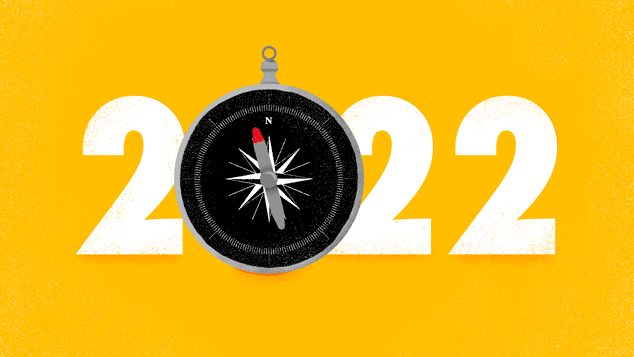From rocky political transitions to supply-chain disruption, growing economic momentum to the risks of virus mutations and climate change, the last year has given us cause for great hope and concern. But amid the uncertainty, there has been one central thread: an accelerating pace of change that forces organizations and their leaders to adapt or fall behind.
We can’t predict what shocks 2022 may bring, but we’ve seen over the past two years that certain strategies can make organizations better able to roll with the punches and prosper.
First, leaders need to recognize that everything starts with people: your employees, your customers, and the wider community in which you operate. A chief executive has always needed to inspire and motivate employees around a vision and communicate that to shareholders and customers, but the pandemic has raised that challenge to new heights. The quits rate in the United States has hit a record high of 3% a month, so companies have to work extra hard to attract and retain talent – or face the need to replace a third of their workforce each year before accounting for growth.
Leaders need to communicate clearly, frequently, and authentically with their people. Companies that overcame existential threats in sectors like travel, hospitality, and retail sustained morale through big payroll cutbacks by explaining the rationale and showing how painful decisions would enable the enterprise to survive and thrive. Communication is essential to remaining agile in the face of fresh disruptions like the omicron variant and striking the right balance of remote and in-person work.
Second, lead with values. Society is changing, and the pandemic has accelerated the generational shift in the workforce. The US labor participation rate, for instance, has recovered fastest from the blow of COVID-19 among lower age brackets but hardly at all among those aged 55 and older. What you sell and how you operate is increasingly tied with to what you believe and practice. That doesn’t mean virtue signaling but it does increase the pressure on companies to attract and promote a younger and more diverse workforce so they can develop the best ideas and stay in touch with consumers.
Third, frame everything through the lens of sustainability. We saw growing evidence of the risks of climate change during 2021 and a big increase in commitments to reduce greenhouse gas emissions at COP26. Countries and companies now need to make good on those pledges by stepping up efforts to reduce their carbon footprints and get on a path to net zero. Capital and talent are flowing to organizations that are innovating to be part of the solution.
That’s an agenda for positive change that can foster growth and sustainability. Here is what that should mean in several key sectors.
The recent COP26 climate change summit spurred companies and governments from around the world to step up their commitments to reducing carbon emissions and reaching net zero. In 2022, these actors need to start turning pledges into tangible action.
That starts with greater transparency to hold organizations’ feet to the fire. Over a thousand financial institutions responsible for $194 trillion in assets support the recommendations of the Task Force on Climate-related Financial Disclosures (TCFD), which aim to use transparency to steer capital toward sustainable business models. Yet a majority of the corporate sector, which generates the bulk of global carbon emissions, doesn’t yet provide a full accounting of its climate risks. Regulators can move the needle by requiring disclosures. In the European Union, one of eight jurisdictions that is phasing in a mandate to disclose climate risks, companies meet 50% of the TCFD’s recommended disclosures compared with only 20% for corporates in North America, where regulators are studying disclosure mandates but haven’t required them.
Companies also should increase efforts to place more women in leadership positions with responsibility for climate-related strategies. Research shows that women are more open than men to changes that can reduce carbon emissions, but they are underrepresented in positions of real authority. By linking climate and diversity goals, companies can speed up their climate transition and create a more-inclusive environment that strengthens the organization’s culture and business.
Digital Money: A Framework for Safety and Innovation
The surge of cryptocurrencies and decentralized finance (DeFi), and China’s introduction of a central bank digital currency, the eCNY, herald a revolution in the way we perceive and use money. With the Federal Reserve, the European Central Bank, and others considering launching their own CBDCs, it’s vital to set the right ground rules early if we hope to reap the benefits of speed, lower costs, and greater financial inclusion while minimizing risks.
Policymakers should start in 2022 by laying out a clear vision for what they hope to achieve with a CBDC, and consult and communicate clearly with the private sector and the public. The choice of technology solutions can have major implications for the degree of privacy in transactions and the roles that established financial institutions and upstarts will play in extending credit or handling payments. Central banks also should launch technical experiments and keep a close eye on developments in the private sector, including stablecoins and new forms of digital assets, to guide their decisions.
A financial system that’s open to everyone, fosters innovation and competition, and promotes trust and security would be a great achievement, but it won’t happen on its own. Policymakers need to proceed with intentionality and determination. And the private sector can play its part by promoting business models that innovate and deliver value with safety.
Cyber: Moving From Awareness to Preparedness
The last year provided more wake-up calls than any organization should need about the risks of cyberattack, with ransomware thieves disrupting a major US fuel pipeline and meat processor, and other malicious actors penetrating widely used software to compromise dozens of companies and US government agencies.
In 2022, industry needs to use this heightened awareness to make fundamental changes in management strategy and digital operations to embed stronger cybersecurity in their culture and practices. The European Union may set the agenda here with its proposed digital operational resilience rules for financial institutions, a kind of cyber equivalent of the EU’s General Data Protection Regulation, but companies shouldn’t wait for rules to act.
Cybersecurity demands a whole-of-organization mobilization. Senior management needs to start from the assumption of an attack and have a playbook ready in advance, one that identifies the organization’s essential data assets, the potential economic consequences of a breach, and whether ransomware will be paid. They need to work with partners to screen for vulnerabilities deep in their supply chains, including software that can contain decades-old coding modules. Organizations also need to undertake frequent exercises to enhance cyber awareness across the workforce and reduce the risks of employees inadvertently downloading malware.
Making Mobility Networks Greener
Transportation will play a key role as cities seek to recover from the disruption of the pandemic, and given that the sector accounts for 15% of global greenhouse gas emissions, sustainability should be at the top of the agenda for 2022.
That starts with rebuilding mass transit, which remains the most efficient and equitable means for people to get around. town. Innovating with discounted fares, as San Francisco has done, or flexible transit passes that suit a hybrid work schedule can play a big role in luring riders back to the metro and buses. Equally important is the need to restore the frequency of public transit service and developing multimodal hubs and apps to enable commuters to seamlessly connect with ride-hailing, bike-sharing and other services.
Cities also should promote greater electrification of transport to reduce emissions and air pollution. They can electrify bus fleets relatively quickly, as Latin American cities including Bogota and Santiago are doing, while Oslo has shown how incentives like free parking and charging can encourage the mass adoption of electric vehicles, or EVs, by motorists.
4.37 billion
– Number of people – about 57% of the global population – who have received at least one dose of the COVID-19 vaccine.
Source: NY Times
42%
– Share of Americans who made their holiday purchases early this year because of supply chain concerns. They are expected to spend on average $998 on the seasonal holidays, including $648 on gifts.
Sources: Oliver Wyman Forum Global Consumer Sentiment Survey, National Retail Federation
$111.9 billion
– Amount UK shoppers are expected to spend this holiday season, followed by German consumers at $98.7 billion. After falling in 2020, UK retail sales are expected to increase by 6.3% in 2021, rising beyond pre-pandemic levels.
Source: VoucherCodes
1. The United Nations’ declaration that the climate crisis is a “code red” for humanity applies just as well to corporate CEOs. Companies that embrace a net zero vision and invest in decarbonizing their products and processes can ride a green wave of innovation and secure their futures – and the planet’s.
2. The debate over artificial intelligence (AI) is over – it is a “must-have” technology for companies. The question is how best to apply it. To get the biggest return, companies should focus their AI efforts on sharpening predictions, boosting efficiencies, and optimizing real-time strategies in areas like pricing.
3. From “sea snot” and algae blooms, to the rise of “climate refugees” and record temperatures, to new grape varieties that can adapt to a changing Bordeaux region, this stunning interactive shows how climate change is reshaping reality in 193 countries around the world.
4. The United Kingdom’s Royal College of Art is doubling down on its vision of powering wealth and job creation by bridging the creative arts with science.


